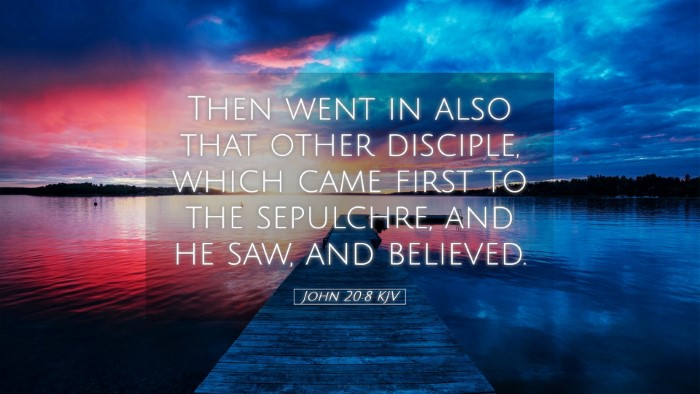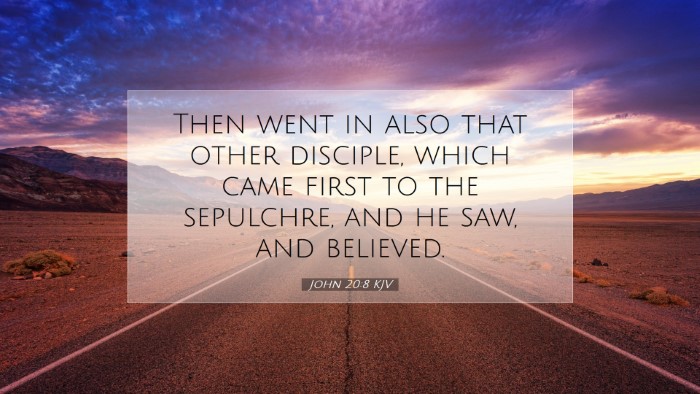Commentary on John 20:8
John 20:8: "Then went in also that other disciple, which came first to the sepulchre, and he saw, and believed."
Contextual Background
The resurrection narrative in the Gospel of John emphasizes the discovery of the empty tomb by Mary Magdalene, after which she informs Peter and the other disciple (traditionally understood to be John himself). The verse in question depicts the moment when this other disciple enters the tomb and believes in the resurrection of Jesus. Understanding this moment requires grasping the surrounding events and the narrative’s theological implications.
The Significance of the Empty Tomb
According to Matthew Henry, the empty tomb serves as a profound testament to the fulfillment of Christ's promises regarding His resurrection. The encounter at the sepulchre symbolizes a pivotal moment in Christian faith, established on the historical truth of the resurrection.
Similarly, Albert Barnes underscores this event as the cornerstone of Christian doctrine, where the resurrection is not merely a narrative device but a foundational belief that underscores the validity of Jesus as the Messiah.
Key Insight: The empty tomb represents the triumph over death and the assurance of eternal life offered to believers, establishing a powerful hope within the Christian message.
The Role of the Disciples
This particular verse highlights the spontaneity and readiness of "the other disciple," who is often considered as the beloved disciple, to engage with the moment. Adam Clarke points out that the belief of this disciple is significant, as his swift action and quick understanding reflect a deeper faith journey.
The term “believed” indicates a clear moment of realization and faith, marking a transition from doubt to assurance. Clarke emphasizes that the act of seeing led to belief, which is a theme prevalent throughout the Gospel of John.
- Faith's Manifestation: "Seeing" is often associated with understanding in John's writings, which foregrounds the importance of faith in the unseen (cf. John 20:29).
- Contrast with Mary Magdalene: The reaction of the disciple serves in contrast to Mary, who initially sees but doesn't immediately comprehend the implications of the resurrection.
Theological Implications
The belief of the disciple speaks volumes about the nature of faith. Matthew Henry articulates that faith often precedes complete understanding; seeing the empty tomb sparked immediate faith in the disciple. This mirrors the nature of belief termed "faith seeking understanding," a point emphasized in theological discourses throughout church history.
Importance of Revelation: Albert Barnes indicates that faith is a response to revelation. The disciple's belief upon entering the tomb signifies not just seeing the evidence but responding to the revelation of Christ as alive. This emphasizes the importance of divine revelation in the life of a believer.
Historical and Cultural Context
Understanding the cultural ramifications of the resurrection narrative is crucial. At the time, the recognition of women's testimony was often undervalued, yet it is women who first witness the resurrection. Adam Clarke notes that John’s Gospel strategically positions the male disciples' belief alongside Mary's initial testimony, elevating her role despite cultural biases.
Cultural Commentary: The embrace of the female perspective within the resurrection narrative challenges cultural norms and affirms the truth that the resurrection message is for all, breaking barriers of gender and status.
Conclusion and Application
John 20:8 encapsulates a moment of transformation, where seeing leads to belief. For pastors and theologians, this verse emphasizes the necessity of faith as a dynamic response to divine revelation. It evokes questions regarding how faith is awakened in moments of uncertainty and despair.
Furthermore, this scripture compels believers to examine their own responses to Christ's resurrection. It asks: "What does it mean to see and truly believe?" It prompts an exploration of faith that involves trust beyond mere evidence, urging a deeper relationship with the risen Lord.


